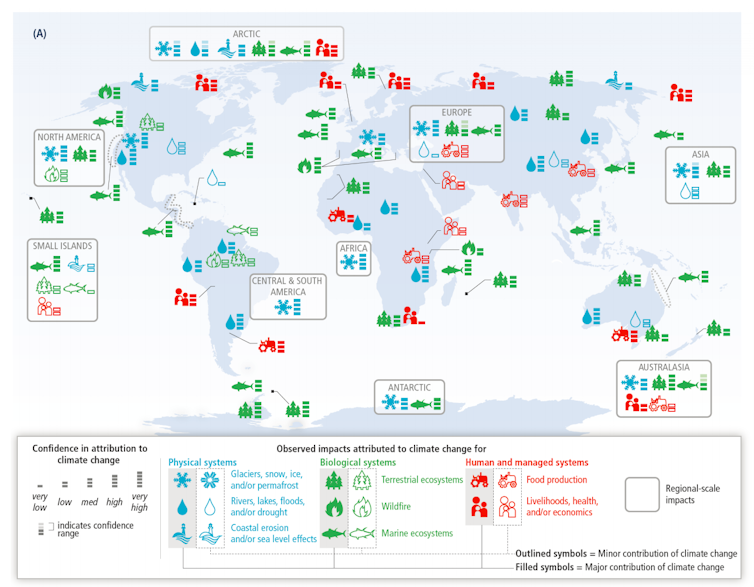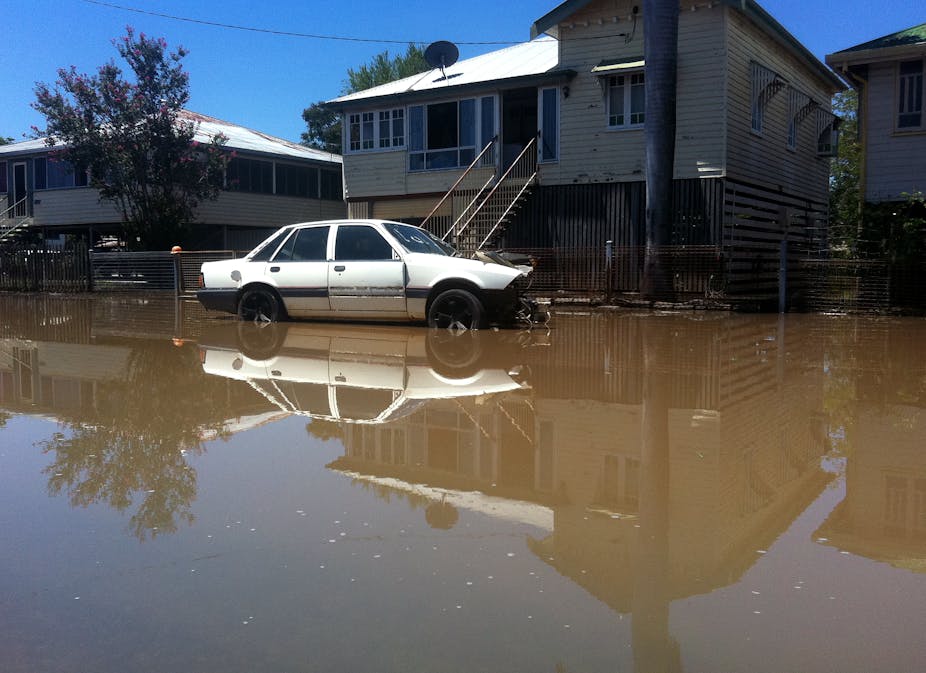Despite the mounting evidence, there are still some who would deny the veracity of human-caused climate change and its potential to disrupt and harm our communities.
Most dissenters rely on non-expert sources, which tend to have low grades of analysis, review and scientific integrity. Not so with the Intergovernmental Panel on Climate Change report, the latest part of which has been released today.
Involving hundreds of the world’s most qualified experts, the report focuses on the impacts, adaptation and vulnerability of ecosystems, economics and people to climate change. There is nothing lightweight about it.
Like the Working Group I report, released in September last year, it stretches to more than 2,000 pages and has involved more than 50,000 responses to hundreds of reviewers.
And the messages from Working Group II are also pretty stark. Here are some of those messages.
“Human interference with the climate system is occurring, and climate change poses risks for human and natural systems.”
The latest report makes no bones about stating the consensus that human-driven climate change is occurring and it is important. Hundreds of changes have already been observed that are consistent with climate change, temperature rises (documented below), and associated issues such as ocean acidification.

The most important of these impacts are detailed on the map below, and include threats to ecosystems and organisms, increasing coastal erosion and inundation, decreasing crop yields, and intensifying flood frequency.

The challenge of managing risks
Risk is a prominent theme in the new report. Whether it be understanding the vulnerability of people and systems to climate change, or the benefits of adaptation, the IPCC’s Working Group II is couching its consensus, analysis and language in terms of “risk”, more so than the concepts of “vulnerability” and “exposure” discussed in previous reports.
The reason for this change comes from the perception that risk is more widely understood by the general public than the previous terms.
People understand managing and avoiding risk from an early age. Whether it is the tree you climbed as a child, or your decision to reduce your risk of harm by wearing a bike helmet, risk and its management is a familiar concept.

The new report summarises the expert consensus on risk and gives new insights into how those risks might change in the face of 2C or 4C of global warming. Importantly, the consensus report includes an assessment of whether the resultant risks can be reduced by adaptation.
Adaptation, as you might remember, refers to our ability as people and communities to take steps to reduce the impacts of climate change. As can be seen from looking at the examples in the table below, in most cases our adaptation options for reducing risk are limited, especially if we fail to take action that might curb temperature rises.
Oceans in flux
One of the new features of the current assessment is the greater focus on the world’s oceans. In previous IPCC reports, discussion of the ocean has been split across systems and regional chapters, reducing the opportunity to look at the bigger picture of how climate change broadly affects the ocean as a whole.
In the current assessment, the ocean (which, of course, covers 71% of Earth’s surface) is considered in a single new regional chapter, allowing all aspects of this massive system to be pulled together.

One of the outcomes of this chapter is a much improved understanding of whether climate change has is affecting marine organisms and ecosystems.
This type of information and understanding has been available for terrestrial systems going back to before the previous IPCC assessment in 2007. In 2003, for instance, many terrestrial species were found to have moved polewards – a discovery that was later confirmed. But similar understanding was lacking for ocean species.
The new report fills in this gap, thanks largely to CSIRO’s Elvira Poloczanska and colleagues, who assessed 1735 marine biological responses and found that 81-83% of these published studies that showed changes that were consistent with ocean warming and other climate change related changes.
That is an amazing number, and it means that life in the ocean is mostly on the move in response to the changing conditions foisted on it by climate change.

With populations of economically important organisms such as fish travelling towards the polar regions at rates of up to 200 km per decade, industries such as fishing are experiencing new challenges associated with shifting resources.
In some cases, such as high-latitude fisheries off the Scandinavian coast, fisheries are experiencing increased catch rates as ice retreats and waters warm. But these benefits are likely to be short-lived, as further warming will eventually rob these fish species of their optimum living conditions.
Our ability to adapt is limited at best
The latest IPCC report clearly shows that the consensus on changes in risk under future warming and that adaptive capacity is limited at best in terms of countering the growth of vulnerability.

When you read the 44-page Summary for Policy Makers released today, one thing that jumps out is the table of key risks and possible adaptation responses needed for each continent, small islands and the world’s oceans – even with only small amounts of climate change. If you are someone charged with the job of devising adaptation strategies, your eyes would no doubt be watering.
What struck me when I first looked at the aggregated risks, adaptive possibilities and resultant vulnerabilities (such as the one shown below), was how little adaptation might achieve if we head into a world that is 2C or 4C warmer. The second thought was how expensive each option is in terms of time and resources, especially given that all have to be dealt with and cannot be seen in isolation.

The cost of inaction
The third thought is one that concerns the economic argument for bringing our emissions globally to zero over the next two decades, versus trying to adapt to the changes – the subject of next month’s IPCC Working Group III report.
It argues from a powerful expert consensus among many scientists that the cost of trying to adapt to the very long list of climate change threats is likely to be excessive compared to the strategy of reducing the challenges (emissions) posed by a changing climate in the first place.
In other words – and I am far from being the first person to make this point – the need to act on climate change is an economic as well as environmental argument.
In the words of Bill Clinton: it’s the economy, stupid. Those who think adapting to climate change looks worryingly expensive would do well to start arguing in favour of spending money on reducing its effects.

